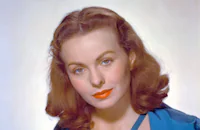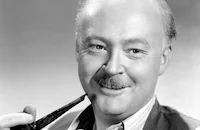Winged Victory
Cast & Crew
George Cukor
Sgt. Mark Daniels
Sgt. Edmond O'brien
Pvt. Lon Mccallister
Cpl. Don Taylor
Cpl. Lee J. Cobb
Film Details
Technical Specs

Synopsis
Along with his best friends Allan Ross and Frankie Davis, Danny "Pinky" Scariano, a barber in the small town of Mapleton, Ohio, dreams of the day when he will be inducted into the service and given the chance to fly planes for the Air Force. As soon as the newly married Allan receives his much-anticipated induction notice, his wife Dorothy declares that she plans to go with him to aviation school and training camp. A short time later, Pinky and Frankie get their induction papers and are sent with Allan to the Air Force academy. There the cadets are issued uniforms and given a battery of tests measuring, among other things, their coordination and reflexes. The tests are grueling, and Allan begins to wonder if Frankie will be able to pass them. Frankie, whose hometown bride Jane is living with Dorothy near camp, watches with concern as some of the other cadets receive "wash-out tickets" and is relieved when he is passed over. One of the cadets, Peter Clark, convinces the school's review board that his poor scores were due to the fact that his sister had just told him that his girl friend was seeing another man. When Pinky is called before the board and informed that he has failed his depth perception test, he breaks down in tears. Because of his failed test, Pinky is classified a gunner and ships out for separate training, while Frankie, Allan and their friends, Irving Miller from Brooklyn and Bobby Grills, a farmer from Washington State, are assigned to pilot school. During the cadets' first night flight, one of the planes crashes, but the identity of the pilot is not known. The cadets nervously await the news of the dead, and Allan is devastated when he realizes that Frankie was the doomed man. With a heavy heart, Allan goes to tell the tragic news to Jane, who had decided not to tell Frankie that she was pregnant. Later, the cadets, having just graduated from flight school, are assigned to their units. To his joy, Pinky is assigned to the same plane as Allan and Irv, and together with their five crew mates, they name their craft "Winged Victory." The fliers are soon given orders to join the fighting in the South Pacific, but, before leaving, they enjoy one last reunion with their wives in San Francisco. Although the men refuse to reveal that they are shipping out the next morning, the women know the truth and struggle to accept the long wait ahead of them. Later, at their South Pacific base, the crew of the "Winged Victory," exhausted from an all-night patrol, join the other crews in a Christmas celebration. In the midst of the festivities, an air raid siren sounds, and the planes take off for battle. A tire on the "Winged Victory" is damaged during combat, and Pinky is injured. After the plane makes a rough but safe landing at the base and Pinky is rushed away in an ambulance, Allan learns that his wife has given birth to a son. Allan shares his good news with Pinky, whose recovery is assured, and before taking off to rejoin the battle, writes a letter to his son, explaining the importance of his mission and his hopes for the future.

Director

George Cukor
Cast
Sgt. Mark Daniels
Sgt. Edmond O'brien
Pvt. Lon Mccallister

Cpl. Don Taylor

Cpl. Lee J. Cobb

T/sgt. Peter Lind Hayes

Cpl. Alan Baxter

Cpl. Red Buttons

Cpl. Barry Nelson
Sgt. Rune Hultman
Cpl. Bernard J. Tyers
Cpl. Phillip Bourneuf

Cpl. Garry Merrill

Cpl. Whitner N. Bissell

Sgt. George Reeves
Pfc. George Petrie
Pfc. Alfred Ryder

Cpl. Karl Malden
Pfc. Martin Ritt
Pfc. Harry Lewis
S/sgt. Fred A. Cotton
Cpl. Henry Rowland
Lt. Gilbert Herman
S/sgt. Sascha Brastoff
Cpl. Archie Robbins
Cpl. Jack Slate
Cpl. Henry Slate

Jeanne Crain
Jane Ball
Jo-carroll Dennison

Judy Holliday

Geraldine Wall
George Humbert
Cpl. Richard Hogan
Cpl. Damian O'flynn
Capt. Ray Bidwell
Lt. Carroll Riddle
Timmy Hawkins
Moyna Macgill
Frances Gladwin
Sally Yarnell
Norman Mendelssohn

Kevin Mccarthy
Pvt. Claude Stroud
Sgt. Zeke Manners
Jack Powell

Ray Mcdonald
Jerry Adler
Jack Powell
Patricia Moore

Don Beddoe
Capt. Biddle
J. Larrimore
E. Ott
Beth Willy
Mary Scott
Crew
Joseph Behm
Elton Box
Harry Brand
Sascha Brastoff
Major William J. Clinch
Desmond Cox
Robert Crawford
Lewis Creber
Dorothy Fields
Tod B. Galloway
E. Ray Goetz
Mack Gordon
Eugene Grossman
Franz Gruber
Edwin Hammeras
Ralph O. Hammeras
Moss Hart
Roger Heman
Sgt. Harry Horner
Percy Ikerd
Charlotte Kackley
R. A. Klune
John Larkin
Capt. Irving Lazar
Charles Le Maire
Lester Lee
Edgar Leslie
Thomas Little
Glen Macwilliams
Zeke Manners
Jimmy Mchugh
Barbara Mclean
George W. Meyer
Meade Minnigerode
Joseph Mohr
May Morris
Kay Nelson
Ben Nye
Al Orenbach
Lt. Leonard De Paur
Guy Pearce
George S. Pomeroy
Frances Richardson
Sgt. David Rose
David Rose
Irving Rosenberg
Fred Sersen
Nat Simon
Edward Snyder
Murray Spivack
Lee Strasberg
Charlie Tobias
Harry Tobias
Vinton Vernon
Harry Warren
Lyle Wheeler
Darryl F. Zanuck

Film Details
Technical Specs

Quotes
Trivia
Notes
The film's title card reads: "Twentieth Century-Fox in Association with The U.S. Army Air Forces Presents Moss Hart's Winged Victory." The opening credits conclude with the following statement: "In this picture all the boys in uniform are members of the U.S. Army Air Forces." The training and testing sequence in the film features two fast-talking, off-screen narrators. Most of the musical numbers are performed by a male chorus, without instrumental accompaniment. Red Buttons and Jack and Henry Slate impersonate the Andrews Sisters in the film, and Sascha Brastoff impersonates Carmen Miranda. For their numbers, "Pennsylvania Polka" and "Chica, Chica, Boom, Chic," respectively, the actors mouth the words to the songs as phonograph recordings of the actual singers are played.
Contemporary news items and studio publicity material, contained at the AMPAS Library, provide the following information about Hart's play and its screen adaptation: In early 1943, General Henry H. "Hap" Arnold, the commanding general of the Army Air Forces (AAF), asked Hart to write an "intimate story" about AAF fliers. After agreeing, Hart visited various air bases to collect background information for the project. While Hart was writing the play, the AAF conducted auditions at bases around the country, casting approximately 300 AAF personnel in the show. As stipulated in the AAF contract, all cast and crew of the play were active members of the AAF. Hart, who also directed the show, relinquished his salary, and proceeds from the play were donated to the Army Emergency Relief Fund. In late November 1943, soon after the play opened to rave reviews, International Pictures offered to produce a screen version, proposing to put up a $1,000,000 down payment against a percentage of the gross. William Wyler, who was an AAF officer and had recently flown combat missions overseas, was announced as the film's director at that time.
In mid-December 1943, after International's offer apparently was turned down, Twentieth Century-Fox purchased the screen rights to the play, guaranteeing the Army Emergency Relief Fund a minimum of $1,000,000 from the proceeds. As noted in NARS War Department records, the AAF paid for or supplied Twentieth Century-Fox the negative cost of production, 25% of the distribution charge, out-of-pocket expenses for prints, advertising, exploitation and other direct charges and six million feet of raw 35mm stock. The studio agreed to use the entire cast, orchestra and other personnel from the play, as well as Wyler as director. In mid-March 1944, however, Wyler received permission to return to the front and George Cukor was hired as the film's new director. Hart was to "supervise" the production, which, according to a late March 1944 Hollywood Reporter news item, was to be shot in Technicolor.
According to the Twentieth Century-Fox Records of the Legal Department, located at the UCLA Arts-Special Collections Library, Jerry Cady wrote a screen treatment of Hart's play. The extent of his contribution to the final film has not been determined. After the Screen Actors Guild and IATSE approved the use of non-union military personnel in the film, the 300-man cast of the stage play and its commanding officer, Lt. Col. Walter M. Dunham, left New York for Hollywood. On May 29, 1944, the AAF troops marched into the U.S. Army Recreational Camp in Santa Monica, CA, where they were stationed during the film's production. Although the studio's contract with Hart and the AAF stipulated that the top six actors of the stage play, Richard Hogan, Edmond O'Brien, Mark Daniels, Don Taylor, Barry Nelson and Rune Hultman, be cast in the film, Lon McAllister eventually replaced Hogan in the part of "Frankie Davis." Hogan did appear in the picture in a smaller role. It is possible that some of the stage show actors appeared in the film in roles not credited onscreen or in the CBCS. Martin Ritt, who acted in the play and later became well-known as a director, made his screen-acting debut in the picture, as did Karl Malden, Gary Merrill (1915-1990, whose name was spelled "Garry" in the onscreen credits), Red Buttons (1919-2006) and Kevin McCarthy. None of the stage show actresses were cast in the film.
In early May 1944, Hollywood Reporter announced that Ginger Rogers was a "top contender" for a starring role, and in early June 1944, that actor Robert Cummings, a civilian Army flight instructor at the time, was being sought by Twentieth Century-Fox for a "top role." Although studio publicity noted that Pamela Lawrence, the daughter of renowned stage actress Gertrude Lawrence, was to make her screen debut in the picture, her appearance in the completed film has not been confirmed. According to MPAA/PCA files at the AMPAS Library, PCA director Joseph I. Breen objected to the proposed "Andrews Sisters" drag costume, in which coconuts were to be placed over the men's breasts, and the "Carmen Miranda" costume, in which "the man's navel was to appear uncovered." Despite Breen's objections, the costumes were used in the film.
In addition to using actors from the stage production, Twentieth Century-Fox hired the show's scenery designer, Cpl. Harry Horner, its composer, Sgt. David Rose, and its choral director, Lt. Leonard de Paur. A January 1944 studio memo listed lighting director Abe Feder among the personnel to be imported from the stage production, but his contribution to the completed film has not been confirmed. Winged Victory marked the first film credit of noted actor and Group Theatre founder Lee Strasberg, who worked as the picture's dialogue director, and producer Capt. Irving Lazar (the future literary agent who was more commonly known as "Swifty" Lazar), who had been the stage manager of the play and functioned as the film's production manager for at least part of the production. California location shooting took place at the Stockton Air Field in Stockton, Fort MacArthur in San Pedro, and was scheduled to take place in Santa Ana, San Onofre, Cal-Aero Ontario, March Field in Riverside, and at the military base in Pendleton. Many military dignitaries attended the film's New York premiere at the Roxy Theatre and the Los Angeles premiere at Grauman's Chinese Theatre. Los Angeles Mayor Fletcher Bowron declared the week of the picture's opening "Winged Victory" week. More than 600 combat veterans from the AAF Redistribution Center, Santa Ana Army Base and the Birmingham General Hospital in Van Nuys, CA, attended a special pre-release screening of the picture in Hollywood.












